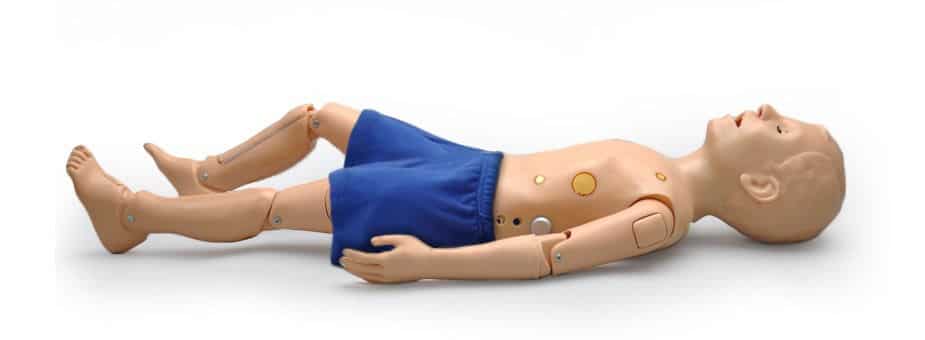HAL® S3005 Five year old pediatric simulator

Sounds
- Extensive speech library
- Heart sounds include a normal heart as well as splits and murmurs
- Respiratory sounds include normal lungs as well as stridor, bronchial, wheezing, pleural friction and crackles
- Bowel sounds
Simulator
- Physical size is 5 years of age
- Self-contained respiratory and circulatory functions
- Active eyes
- NG and otic exercises
- Tracheotomy opening
- Interchangeable genitalia
- Enema administration
- Two way wireless communication
- Internal rechargeable power
Motion
- Fully responsive even when carried
- Body convulses on command
- Eyes open / close and feature slow or rapid blinking
Airway
- Oral and nasal intubation
- Use an ET tube or LMA
- Sensors detect depth of intubation
- Unilateral chest rise with right mainstem intubation
- Multiple upper airway sounds synchronized with breathing
New airway feature
- Realistic geometry and larger epiglottis.
- Better visualization of vocal cords as well as easy intubation.
- Lung compliance refined to deliver chest rise when ventilating at 20cm H2O.
- Improved chest wall recoil during CPR.
Breathing
- Control rate and depth of respiration and observe chest rise.
- Ventilation is measured and logged.
- Gastric distention with excess BVM ventilation.
- Select independent left and right lung sounds.
- Chest rise and lung sounds are synchronized with selectable breathing patterns.
- Accommodates assisted ventilation, including BVM and mechanical support
- Unilateral chest rise and multiple breath sounds
Circulation and color change
- Multiple heart sounds, rates and intensities.
- Chest compressions are measured and logged.
- Blood pressure can be taken using a cuff, palpation, or auscultation
- Korotkoff sounds audible between systolic and diastolic pressures
- Color and vital signs respond to hypoxic events and interventions.
- Bilateral carotid, brachial and radial pulses operate continuously
- Pulse strengths vary with blood pressure and pulses are synchronized with ECG
Active eyes
- Open and close.
- Select blink rate.
- Select pupillary responses to light.
Venous Access
- IV training arms.
- IM sites on shoulders and thighs.
- Intraosseous access at tibia.
Intraosseous infusion
- Intraosseous access at tibia.
CPR
- Improved chest wall recoil during CPR.
Blood pressure
- Blood pressure can be taken using a cuff, palpation, or auscultation.
Defibrillate, Cardiovert and Pace
- Apply real electrodes and AED pads.
- Use real EMS equipment.
- See electrical interventions on your AED or our monitor ECG.
- View ECGs with physiologic variations generated in real-time
- Synchronized with pulses
- Conductive skin regions










